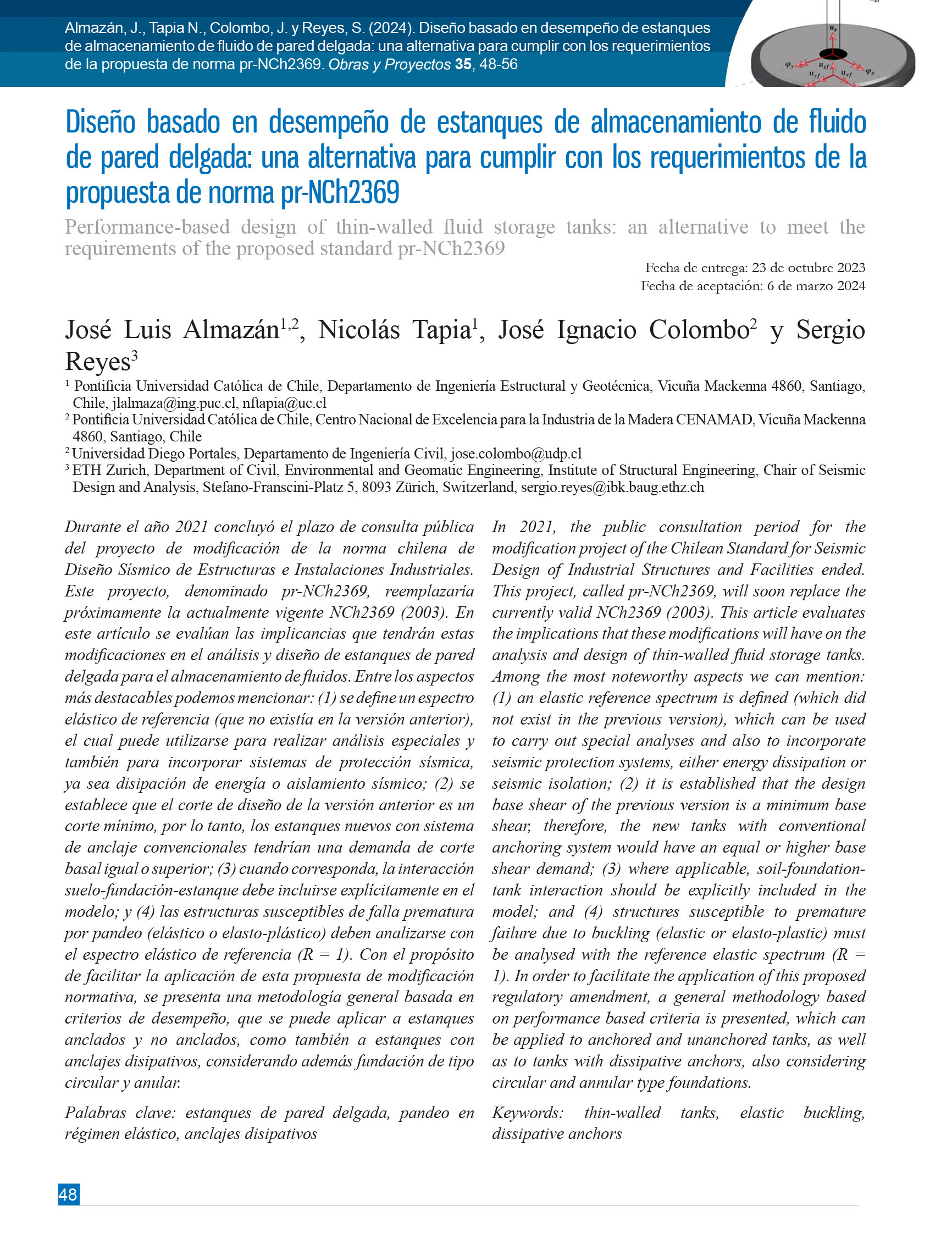Diseño basado en desempeño de estanques de almacenamiento de fluido de pared delgada: una alternativa para cumplir con los requerimientos de la propuesta de norma pr-NCh2369
DOI:
https://doi.org/10.21703/0718-2813.2024.35.2799Palabras clave:
Estanques de pared delgada, Pandeo en régimen elástico, Anclajes disipativosResumen
Durante el año 2021 concluyó el plazo de consulta pública del proyecto de modificación de la norma chilena de Diseño Sísmico de Estructuras e Instalaciones Industriales. Este proyecto, denominado pr-NCh2369, reemplazaría próximamente la actualmente vigente NCh2369 (2003). En este artículo se evalúan las implicancias que tendrán estas modificaciones en el análisis y diseño de estanques de pared delgada para el almacenamiento de fluidos. Entre los aspectos más destacables podemos mencionar: (1) se define un espectro elástico de referencia (que no existía en la versión anterior), el cual puede utilizarse para realizar análisis especiales y también para incorporar sistemas de protección sísmica, ya sea disipación de energía o aislamiento sísmico; (2) se establece que el corte de diseño de la versión anterior es un corte mínimo, por lo tanto, los estanques nuevos con sistema de anclaje convencionales tendrían una demanda de corte basal igual o superior; (3) cuando corresponda, la interacción suelo-fundación-estanque debe incluirse explícitamente en el modelo; y (4) las estructuras susceptibles de falla prematura por pandeo (elástico o elasto-plástico) deben analizarse con el espectro elástico de referencia (R = 1). Con el propósito de facilitar la aplicación de esta propuesta de modificación normativa, se presenta una metodología general basada en criterios de desempeño, que se puede aplicar a estanques anclados y no anclados, como también a estanques con anclajes disipativos, considerando además fundación de tipo circular y anular.
Referencias
Barton, D.C. and Parker, J.V. (1987). Finite element analysis of the seismic response of anchored and unanchored liquid storage tanks. Earthquake Engineering & Structural Dynamics 15(3), 299-322.
Colombo, J.I. and Almazán, J.L. (2019). Simplified 3D model for the uplift analysis of liquid storage tanks. Engineering Structures 196, 109278.
Cruz, E.F. and Valdivia, D. (2011). Performance of industrial facilities in the Chilean earthquake of 27 February 2010. The Structural Design of Tall and Special Buildings 20(1), 83-101.
Dizhur, D., Simkin, G., Giaretton, M., Loporcaro, G., Palermo, A. and Ingham, J. (2017). Performance of winery facilities during the 14 November 2016 Kaikōura earthquake. Bulletin of the New Zealand Society for Earthquake Engineering 50(2), 206-224.
Hall, J.F. (1995). Northridge earthquake January 17, 1994. Reconnaissance Report. EERI, Oakland, USA.
Hanson, R.D. (1973). Behavior of liquid-storage tanks. The Great Alaska Earthquake of 1964, 331–339.
Haroun, M.A. and Housner, G.W. (1981). Earthquake response of deformable liquid storage tanks. Journal of Applied Mechanics 48(2), 411-418.
Housner, G.W. (1963). The dynamic behavior of water tanks. Bulletin of the Seismological Society of America 53(2), 381-387.
Housner, G.W. (1957). Dynamic pressures on accelerated fluid containers. Bulletin of the Seismological Society of America 47(1), 15-35.
Jacobsen, L.S. (1949). Impulsive hydrodynamics of fluid inside a cylindrical tank and of fluid surrounding a cylindrical pier. Bulletin of the Seismological Society of America 39(3), 189-204.
Jaramillo, F., Almazán, J.L. and Colombo, J.I. (2022). Effects of the anchor bolts and soil flexibility on the seismic response of cylindrical steel liquid storage tanks. Engineering Structures 263, 114353.
Malhotra, P. (2000). Practical nonlinear seismic analysis of tanks. Earthquake Spectra 16(2), 473-492.
Malhotra, P.K. and Veletsos, A.S. (1994a). Beam model for base-uplifting analysis of cylindrical tanks. Journal of Structural Engineering 120(12), 3471-3488.
Malhotra, P.K. and Veletsos, A.S. (1994b). Uplifting analysis of base plates in cylindrical tanks. Journal of Structural Engineering 120(12), 3489-3505.
Malhotra, P.K. and Veletsos, A.S. (1994c). Uplifting response of unanchored liquid-storage tanks. Journal of Structural Engineering 120(12), 3525-3547.
Manos, G.C. (1991). Evaluation of the earthquake performance of anchored wine tanks during the San Juan, Argentina, 1977 earthquake. Earthquake Engineering & Structural Dynamics 20(12), 1099–1114.
Moreno, M., Colombo, J., Wilches, J., Reyes, S. and Almazán, J. (2023). Buckling of steel tanks under earthquake loading: Code provisions vs FEM comparison. Journal of Constructional Steel Research 209, 108042.
Morris, G.J., Bradley, B.A., Walker, A. and Matuschka, T. (2013). Ground motions and damage observations in the Marlborough region from the 2013 Lake Grassmere earthquake. Bulletin of the New Zealand Society for Earthquake Engineering 46(4), 169- 187.
NCh2369 (2003). Earthquake resistant design of industrial structures and facilities. Instituto Nacional de Normalización INN, Santiago, Chile.
NZSEE (1986). Seismic design of storage tanks. New Zealand National Society for Earthquake Engineering, Wellington, New Zealand.
Peek, R. and Jennings, P.C. (1988). Simplified analysis of unanchored tanks. Earthquake Engineering & Structural Dynamics 16(7), 1073-1085.
Steinbrugge, K.V. and Flores, R. (1963). The Chilean earthquakes of May, 1960: A structural engineering viewpoint. Bulletin of the Seismological Society of America 53(2), 225–307.
Tapia, N.F., Almazán, J.L., Valdebenito, N. and Reyes, S.I. (2023). Experimental validation of an energy-dissipating anchoring system for continuously-supported storage tanks. Structures 55, 2324-2340.
Veletsos, A.S. (1974). Seismic effects in flexible liquid storage tanks. 5th World Conference on Earthquake Engineering, vol. 1, 630-639.
Veletsos, A.S. and Yang, J.Y. (1977). Earthquake response of liquid storage tanks. In Advances in Civil Engineering through Engineering Mechanics. Annual Special Conference, ASCE, Raleigh NC, USA, vol. 5, 1-24.
Virella, J.C., Godoy, L.A. and Suárez, L.E. (2006). Dynamic buckling of anchored steel tanks subjected to horizontal earthquake excitation. Journal of Constructional Steel Research 62(6), 521-531.

Descargas
Publicado
Número
Sección
Licencia

Esta obra está bajo una licencia internacional Creative Commons Atribución-NoComercial 4.0.







